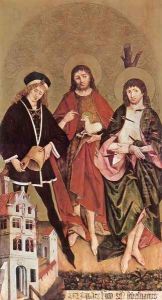Hans II Strigel Paintings
Hans II Strigel, also known as Hans Strigel the Younger, was a late Gothic painter who was active in the region of Memmingen, in what is now Bavaria, Germany, during the 15th century. His approximate year of birth is around 1430, though the exact date is not documented. Strigel came from an established family of artists, and he was the son of Hans Strigel the Elder, who was also a painter. This familial connection provided him with a foundation in the arts and likely his initial training.
Hans II Strigel's work is characterized by its attention to detail, vibrant colors, and the incorporation of both religious and secular themes, which was typical of the period. His oeuvre includes altarpieces, portraits, and frescoes. However, much of his work has not survived or has been hard to attribute definitively due to the common practice of not signing artworks during that time. Despite this, he is known to have been quite prolific and his works were in demand, indicating his success as an artist during his lifetime.
Strigel's paintings often featured well-rendered drapery, expressive faces, and a use of perspective that was becoming more popular at the time due to the influence of the Italian Renaissance. Though he was working in a more Northern Gothic tradition, there are hints in his work of the coming Renaissance, a transition that is seen in many artists of this period.
The records last mention Hans II Strigel in 1488, and while the date of his death is not precisely known, it is generally accepted that he died shortly thereafter. His legacy continued through his family, with descendants who were also artists, contributing to the Strigel family's lasting reputation in the region. Hans II Strigel's works can be found in various museums and collections, offering insights into the art and culture of 15th-century Germany.
